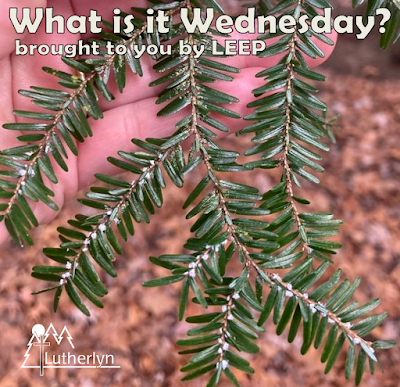Can
you identify what's in this photo?
Each Wednesday morning
on Camp Lutherlyn's Facebook page
the Lutherlyn Environmental
Education Program posts a photo.
Readers
have all morning and afternoon
to
make their best guess about what the photo is.
Around
6 pm LEEP provides the answer and a brief explanation.
Each
week's What is it Wednesday post
will
also be posted on the Nature of Lutherlyn blog,
after it is posted on Facebook,
sometimes
with additional bonus information.
In
addition to bringing you current editions of What is it Wednesday
on the
Nature of Lutherlyn blog,
we
will be reposting old editions,
creating
a What is it Wednesday archive.
This photo was posted as a What is it Wednesday on
December 8, 2021.
And
the answer is....
The little white puffs at the base of the needles hide tiny aphid-like insects that damage hemlock trees by sucking the sap out of the needles. Needles are damaged and die off, and trees cannot get enough nutrients and eventually die. Woolly adelgids are an invasive pest, accidentally introduced from Japan. They have been spreading slowly throughout the eastern United States for several decades, and more recently have been spreading into Western PA in the past 10 years or so. Wooly adelgids here do not fly and only crawl short distances, but do spread by wind and animals. Unfortunately, we spotted them on some of our hemlock trees at Lutherlyn in 2020.
Woolly adelgids, like most invasive species, have no natural predators or controls here. They reproduce asexually by cloning, making it especially difficult to control a population once it is present. Extended periods of cold weather can kill off many of the adelgids, but not every winter gets enough cold weather here to have this effect.
On smaller individual trees, horticultural oils can be applied to smother the adelgids and kill them. On trees that are too large for this treatment, systemic pesticide can be added to the soil or trunk of the tree, which will then kill the insects when they ingest the sap. Both of these treatments are most useful on a small number of trees. This is effective in places where hemlock trees are planted near homes or gardens, or where there are individual trees or small patches that especially important culturally or in an ecosystem.
On a larger scale, where a whole grove or forest is infested, treatment with oils or pesticides is not practical. In some places, primarily state and national parks and forests, predatory beetles have been introduced to help control the population of adelgids. This has helped some, although the adelgid population generally rebounds each year.
At Lutherlyn, we are looking
into whether our affected trees would be good candidates for pesticide
treatment, and if the effects of these pesticides would be limited to the wooly
adelgids or have negative or accumulating effects on other parts of the
ecosystems.
Late fall through early spring is a good time to spot new
infestations. As the adult insects begin to feed in cooler weather, they
secrete a waxy substance that produces the characteristic white fluff that is
visible on the underside of the needles. If you have hemlock trees, now is a good time to check the undersides of lower twigs for this white fluff. If you find woolly adelgids, there are many resources to help you decide what you should do. Penn State Extension offices and the PA DCNR have local resources. Michigan State University also has some excellent and thorough information.
https://extension.psu.edu/hemlock-woolly-adelgid-on-the-rise-this-spring
https://www.dcnr.pa.gov/Conservation/ForestsAndTrees/InsectsAndDiseases/HemlockWoollyAdelgid/Pages/default.aspx
https://www.canr.msu.edu/resources/how_to_treat_hemlock_trees_for_hemlock_woolly_adelgid
At our recent Advent Retreat we asked participants to not use hemlock branches in making their advent wreaths, to avoid accidentally carrying woolly adelgid home with them and spreading them into places that may not already be infested. We can all help slow the spread of woolly adelgid by not transporting hemlock branches.
Like and follow Camp Lutherlyn on Facebook, to see What is it Wednesday posts when they come out and have the opportunity to share your guesses in the comments!


No comments:
Post a Comment